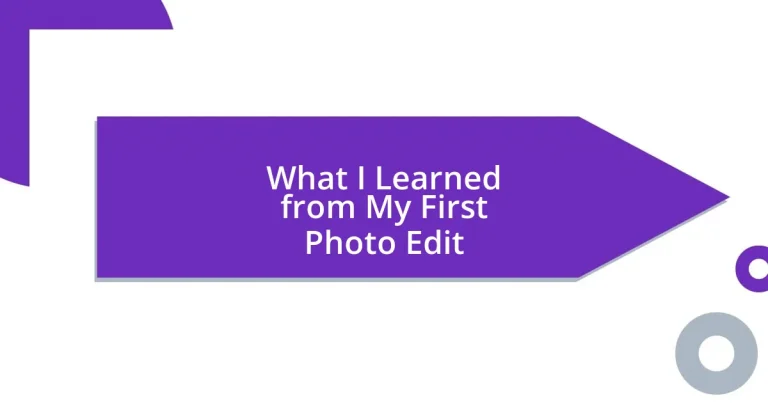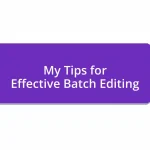Key takeaways:
- Initial photo editing experience combines excitement and intimidation, transforming simple images into personal art forms.
- Essential beginner tools include crop, exposure adjustments, contrast, and saturation to enhance composition and emotional connection.
- Understanding light and color is crucial for creating depth and conveying emotions in images; balance is key to avoid over-processing.
- Taking breaks, setting a clear vision, and embracing constructive feedback are vital for improving editing skills and achieving better results.
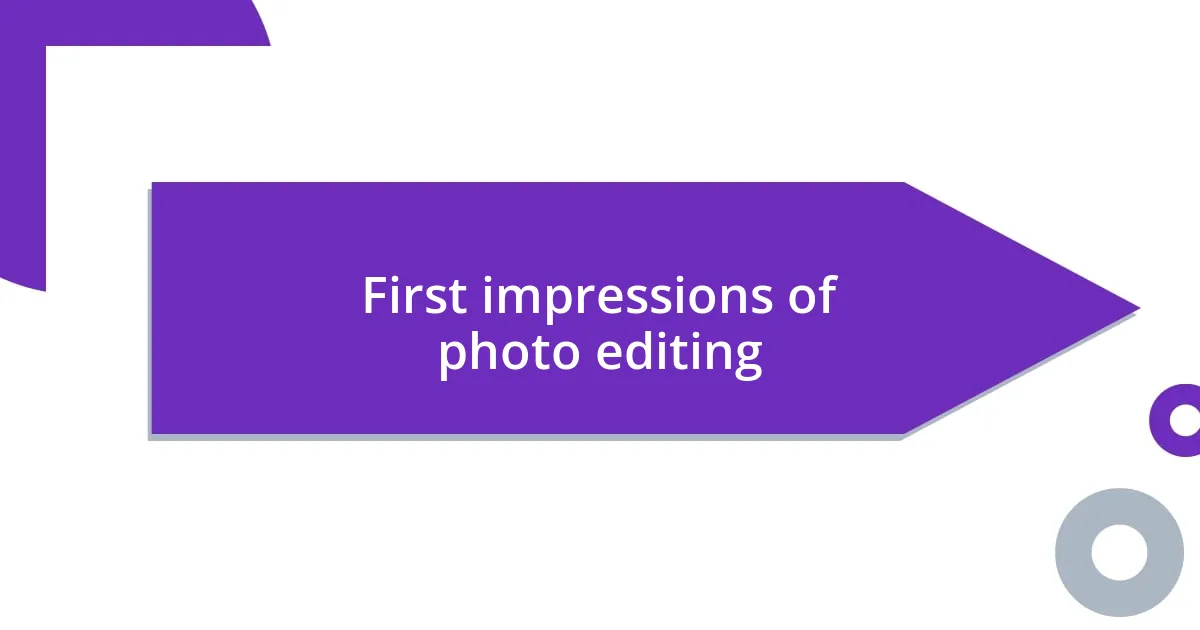
First impressions of photo editing
The first time I dived into photo editing, I remember feeling a mix of excitement and intimidation. As I opened the software, the endless array of tools and options flashed before me like a foreign language. How could I possibly navigate this maze and emerge with something beautiful?
That initial curiosity quickly morphed into wonder as I began adjusting colors and sharpening details. Each small tweak felt like wielding a magic wand, transforming an ordinary snapshot into something that felt uniquely mine. It was a thrilling experience to see my vision come to life, but I also grappled with the overwhelming urge to get everything “right.”
I still recall the joy of my first successful edit—a sunset photo that was transformed from dull to vibrant. Seeing the colors pop made my heart race. In that moment, I realized that photo editing wasn’t just about technical skills; it was an art form that allowed me to express my perspective and creativity in a whole new way.
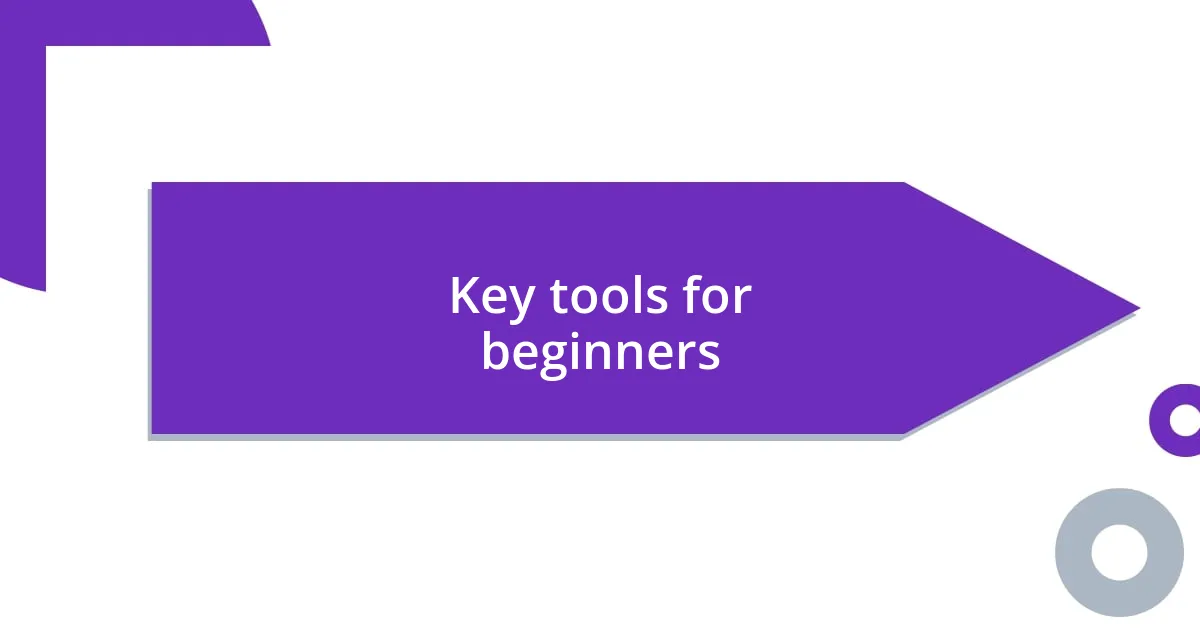
Key tools for beginners
Getting started in photo editing can seem daunting, but having the right tools at your fingertips makes all the difference. When I first began my journey, I found that certain essential tools truly helped me navigate the process. By focusing on a few key functionalities, I gradually built my confidence and learned how to create effective images.
Here are some indispensable tools every beginner should explore:
- Crop Tool: This was my first friend in editing; it helped me instantly improve composition.
- Exposure Adjustments: Playing with exposure taught me how to bring life to my photos, especially in low-light situations.
- Contrast and Saturation: These adjustments were game-changers, allowing me to add depth and vibrance to my images.
- Clone Stamp or Healing Brush: I vividly remember using these tools to remove distracting elements, which felt like I was erasing mistakes from my canvas.
- Filters and Presets: Experimenting with these allowed me to instantly see various moods and styles that resonated with my artistic vision.
As I explored these tools, I discovered that photo editing is as much about intuition as it is about technique. I learned to trust my instincts, gradually developing a personal editing style that felt right for me. Each tool not only enhanced my technical abilities but also deepened my emotional connection to the photos I were transforming.
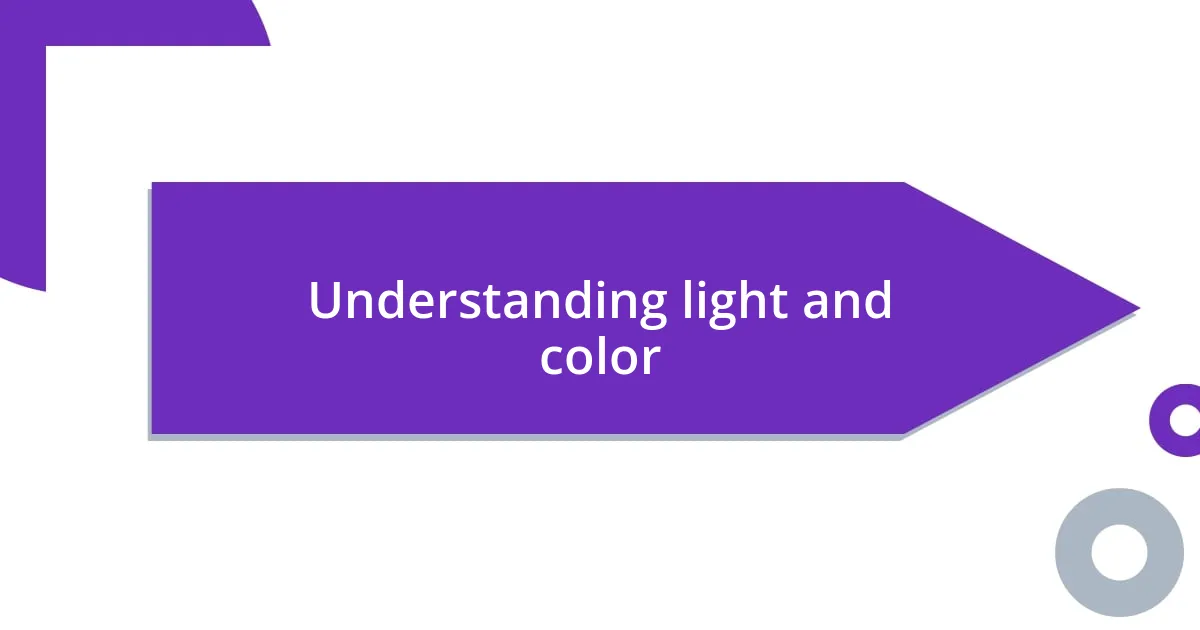
Understanding light and color
Understanding how light and color work together in photo editing was a revelation for me. I remember vividly the first time I adjusted brightness; it was like lifting a veil from my images. Suddenly, I saw details I had previously overlooked. Manipulating shadows and highlights taught me how to create depth and draw attention to focal points, transforming a simple scene into something captivating.
Color, on the other hand, felt like a completely different world. When starting out, I was unsure about saturation and temperature. A particularly memorable moment for me was editing a landscape photo where I pushed the saturation just a tad too far. It looked unnatural, almost cartoonish! That unintentional mishap taught me the delicate balance between enhancing the inherent beauty of a photo and overdoing it. Now, I approach color adjustments with both caution and enthusiasm, eager to make my images resonate yet feel authentic.
The harmony of light and color does more than just enhance an image; it evokes emotions. I have found that warm tones can evoke nostalgia, while cooler tones might create a sense of calm or serenity. I often find myself asking, “What feeling do I want to communicate?” Setting that intention guides my editing process and allows me to connect more genuinely with viewers.
| Aspect | Understanding |
|---|---|
| Light | Affects visibility, depth, and emotion in images. |
| Color | Conveys mood and can alter the viewer’s perception. |
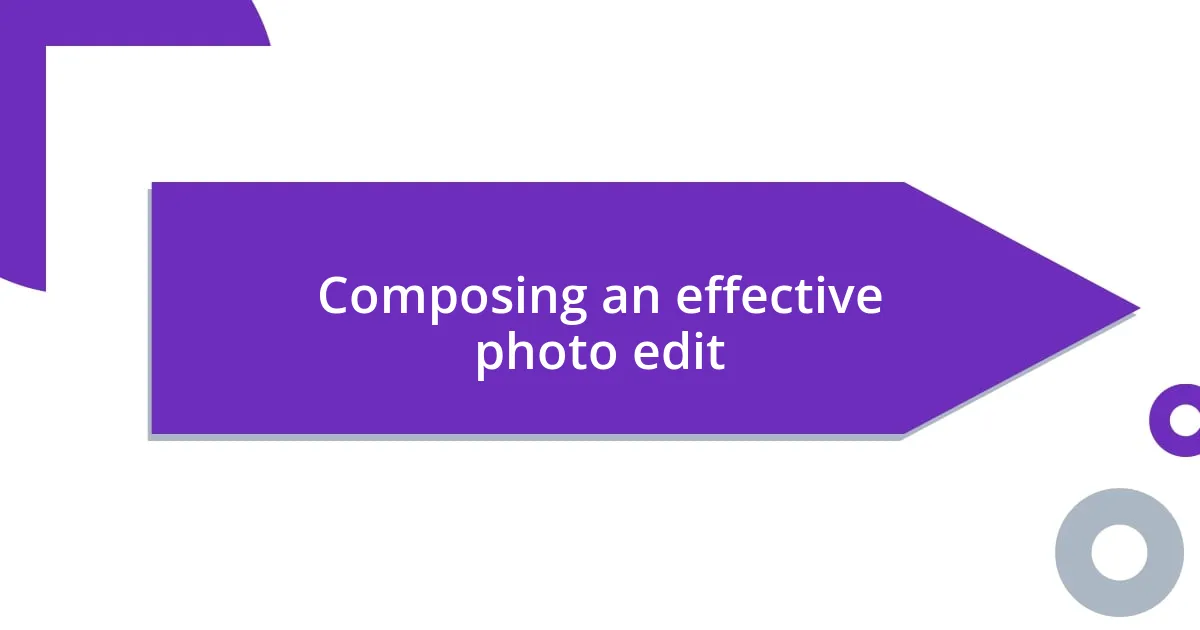
Composing an effective photo edit
Composing an effective photo edit is all about finding the right balance in your adjustments. I remember my first attempts were somewhat overwhelming; I’d pile on filters and tweaks without a clear direction. It was only after stepping back and assessing my work that I realized the beauty lies in subtlety. Less truly can be more, allowing the original image to breathe while still enhancing its essence.
When it comes to composition, I’ve learned the magic of the rule of thirds. I recall a moment when I cropped a landscape photo, applying this technique for the first time. The result was astonishing—I felt like I had uncovered a hidden gem within my own work. That simple, intentional placement of focal points drew viewers in, guiding their eyes through the narrative of the image.
I often ask myself, “What story do I want this edit to tell?” This reflection has become my guiding principle. By keeping this question at the forefront of my mind, I ensure that every adjustment aligns with my vision. The emotional connection to the subject matter enhances not just my editing journey but also the viewer’s experience, making the final product more impactful and relatable.
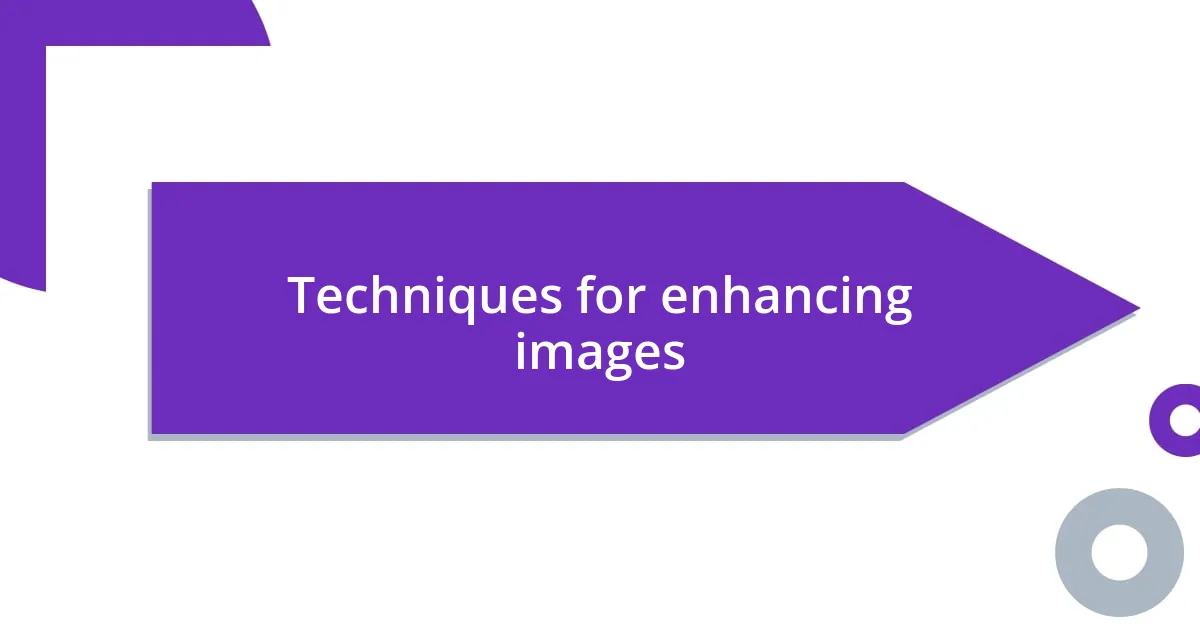
Techniques for enhancing images
Enhancing images often involves experimenting with contrast, which I found crucial during my early editing days. I still remember the first time I cranked up the contrast on a portrait. The expression on my subject’s face jumped to life, becoming more defined and vivid. It made me realize how this simple adjustment can transform not just the image but the entire narrative within it. Have you tried playing with contrast? It can reveal details you never knew were there.
Another technique that brought me joy was sharpening images. In one instance, I edited a close-up shot of a flower. I gently applied sharpening, and the petals suddenly seemed to pop with clarity, showcasing their intricate textures. There’s something exhilarating about making a visual element feel more tangible, almost inviting the viewer to reach out and touch it. It’s like giving your images a new lease on life, isn’t it?
Lastly, let’s not overlook the power of cropping for improvement. I vividly recall the first time I cropped a busy street scene to emphasize a lone figure. The image instantly gained focus, telling a stronger story with just that one change. Cropping not only refines composition but also elevates the subject, creating an emotional connection that can resonate with viewers. I often find myself pondering, “What can I eliminate to enhance what’s truly important?” It’s a question that consistently steers my editing process and leads to images that truly speak.
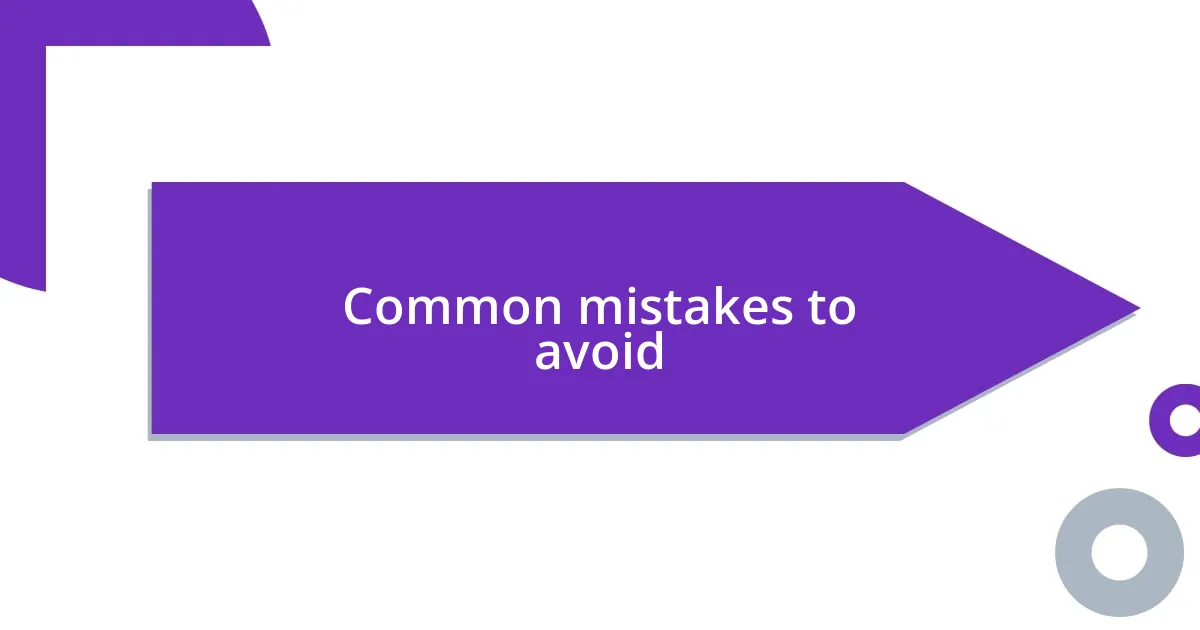
Common mistakes to avoid
One common mistake in photo editing is over-processing. I remember the first time I applied a heavy filter to an image; instead of enhancing it, I completely masked its original beauty. I couldn’t help but feel a little disheartened when I looked at the final result. It taught me that sometimes, it’s best to let the photograph speak for itself. Have you ever overdone it with effects? Taking a step back can really help you see what you might have lost.
Another pitfall is neglecting the importance of color balance. In my early edits, I often let warm tones dominate, thinking it added a cozy feel. However, I later discovered that too much warmth can distort the mood of the photo, making it feel unrealistic. For example, I once edited a sunset picture that ended up looking more like a fire than a beautiful evening sky. Now, I always ask, “Does this color palette enhance the mood or detract from it?” Finding that harmony can be a game-changer.
Lastly, I’ve learned that poor use of shadows can detract from the image’s impact. I vividly recall editing a portrait where I didn’t manage the shadows properly. The subject’s face ended up looking flat, losing the depth that makes a photo come alive. I think shadows are like the unsung heroes of photography; they add dimension and context. When editing, it’s essential to ask, “Which areas need depth?” Balancing light and shadow can turn an ordinary photo into something extraordinary.
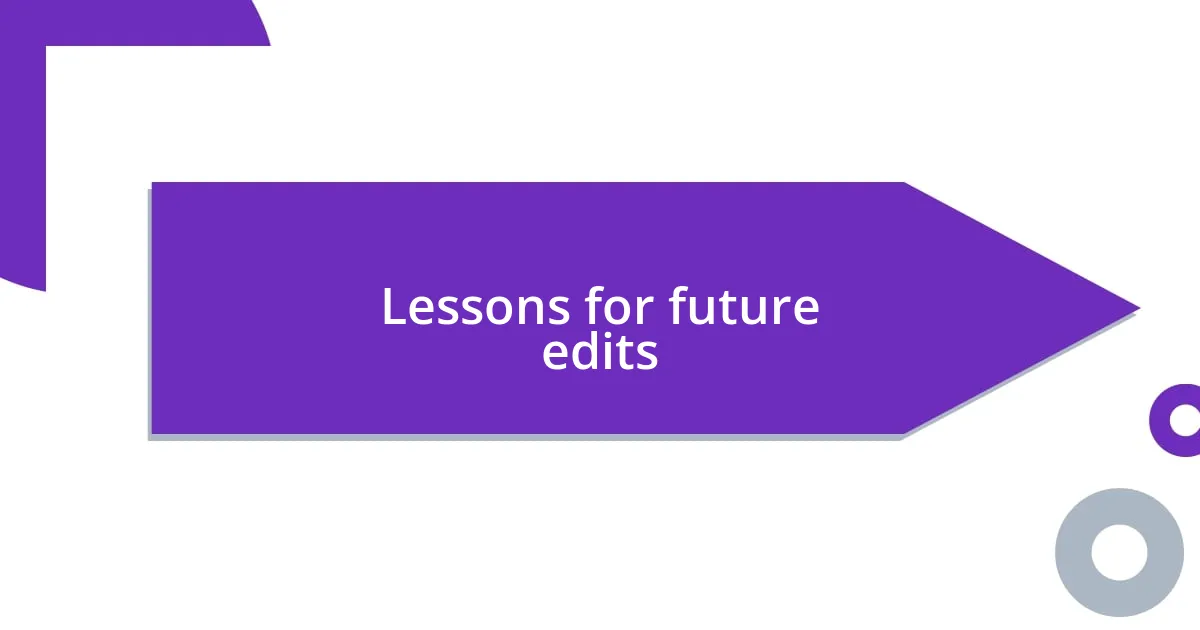
Lessons for future edits
When I reflect on my early photo editing endeavors, one major lesson stands out: the importance of taking breaks. There was a time when I would spend hours glued to my screen, tweaking every detail. One day, I stepped away for just fifteen minutes, and upon returning, I saw mistakes I had missed before. It’s fascinating how fresh eyes can provide clarity. Have you ever felt the relief of stepping back and realizing what truly works or what needs to be fixed?
Another valuable takeaway has been the significance of setting a vision for each edit. Early on, I would work without a clear direction, leading to muddled results. Now, I make it a point to define what I want the photo to express before I start editing. I remember editing a landscape where I envisioned a moody, dramatic atmosphere. By focusing on that vision, I enhanced the darkness and contrast, and the final image not only resonated with my intention but also evoked emotion in others. How often do you think about the story you want to tell with your images?
Lastly, I can’t overemphasize the necessity of learning from each edit. With my first photo modification, I was ecstatic about the result until I received feedback that pointed out areas for improvement. While it stung at first, I realized that constructive criticism is a powerful tool for growth. Each edit became a learning opportunity, shaping my future choices and techniques. Embracing feedback can transform your editing journey into something richer and more fulfilling, don’t you agree?












